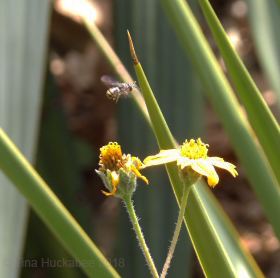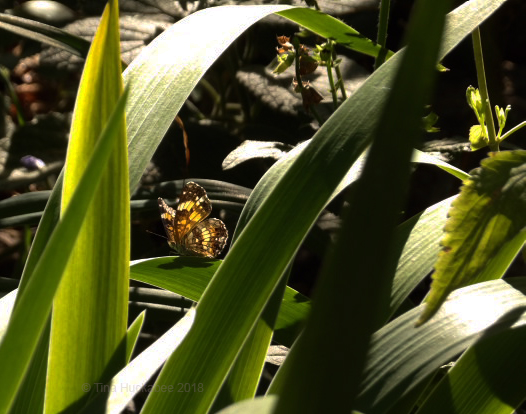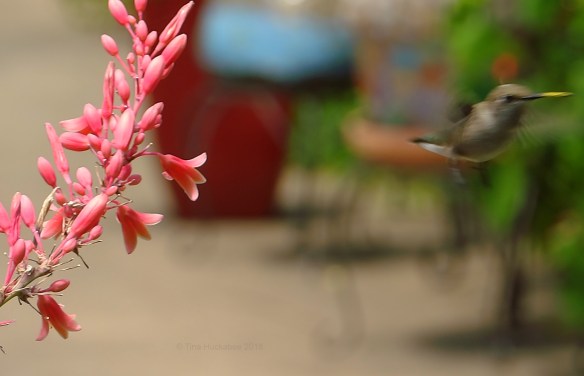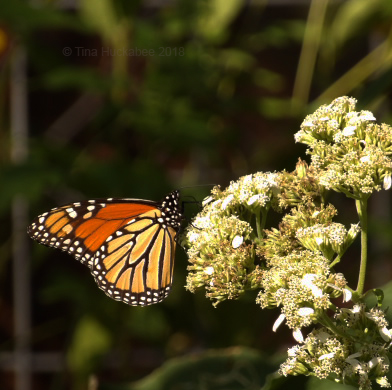This week, June 18-24, marks National Pollinator Week, so proclaimed by the U. S. Senate in 2007. The week’s educational activities focus on the importance of pollinators and on the pressing need to prevent further decline of this importance source of much of our food supply and their role in healthy ecosystems. The devastating decline of pollinators is worldwide and bad– really bad–but today, I find it hard to post about pretty plants and home gardens while my own government is cruelly and nauseatingly separating families seeking a better life–which all of our own ancestors did–as they arrive at our southern border seeking asylum.
America is supposed to be better than this.
Clearly, we are not. Please, please, if you are sickened by this current policy, contact your Senators, your Congress Representatives and the White House to express your outrage and to demand an immediate halt to these abhorrent family separations and offensive incarcerations of children.
The Butterfly
The policy of criminalizing these families and setting them aside as “others” is a dangerous and slippery slope to be traveling upon and Americans should join together to end this abomination.
We should see butterflies–and bees, bats, moths, hummingbirds and a host of other critters–freely in our midst and forever, as they contribute their pollinating gifts to the world. They might seem small and insignificant, but they are vital to our survival and deserve a place to exist and do their work. Like people who are attempting to find a new home and contribute to our community, pollinators are part of the fabric of a healthy society.
A Small Carpenter Bee, Ceratina spp. Apidae, enjoying the bounty of a Shrubby skullcap, Scutellaria wrightii.
Resting from the hard work of pollinating is this unknown butterfly. I think it’s some sort of checkerspot, but I can’t positively identify. Regardless, its beauty and form enhance the garden; its pollination work restores the Earth.
A diminutive Gray Hairstreak, Strymon melinus, likes the petite blooms of an oregano.
Ah, now there’s a pollinator we all know, the busy, buzzy Honeybee.
It’s rare that I get a decent shot of a hummingbird, but this female Ruby-throated Hummingbird, Archilochus colubris, complied with my photographic wishes while sipping from a Red yucca, Hesperaloe parviflora. She’s a regular visitor to this plant, sharing the flowers with another female hummer. Sharing, that is, when they aren’t chasing one another away from the plant!
It’s not a great shot, but check out her beak as she zoomed away from the flowers. Is that yellow pollen coating her nose?
Another leaf-cutting bee, Megachile, rests on a leaf. She’s got a load of pollen on her pollen pantaloons (my term!), also known as corbiculae (scientific term!), but I couldn’t tell if she was nibbling on the leaf. Megachile bees pack their nests with leaf material mixed with soil and pollen.
Another native bee (Megachile?), works oregano blooms.
Oregano is a huge attractor of pollinating insects. I share my oregano with many kinds of pollinating insects. Or, maybe it’s the other way around?
An autumn visitor and Mexican migrant, a Monarch butterfly, Danaus plexippus, nectars from the flowers of Frostweed, Verbesina virginica.
Most of these insects require more than just pretty flowers to feed from. This Black Swallowtail caterpillar, Papilio polyxenes, feeds fennel foliage. It will feed until it’s ready to morph into the adult butterfly. Yes, caterpillars of moths and butterflies munch on plants, but rarely do they munch to the plants’ deaths. The key is to practice gardening patience and understand that munched foliage is often a sign of a vibrant ecosystem.
Aside from allowing larval insects to feed on foliage, what are other practices which encourage healthy pollinator gardens? Well, avoiding the use of pesticides is an excellent beginning. Instead, to limit insect damage, spritz unwanted critters from your plants with water. Or, if you’re inclined, pick off beetles and slower bugs and pop them into soapy water. It doesn’t take long to limit damage to the garden if you’re aware of who’s there and take action immediately.
Leave some part of your property a little bit messy. Let leaves lie; have some bare ground available for ground nesting bees and leave some wood out for those who prefer to raise their families in wood. Build insect hotels; there are many plans available on the Internet and in gardening books and they’re easy to build. Use native plants whenever and wherever you can!
If you plant ‘them’ or build ‘them’ or leave ‘it’ be–pollinators will come!
We have a beautiful country. Let’s take care of it in all its varying forms. Let’s encourage and work toward diversity in our natural landscapes and kindness and humanity in our human communities















Your photos of insects are amazing, Tina, what patience you must possess to get them. It’s true, our insect life is slowly disappearing. As to the other part of your post, what an appalling situation those poor people find themselves in. We have a similar shameful situation in Australia where asylum seekers have been kept on islands for five years and told they’ll never be allowed to settle here, because they came by boat. They have been proven to be genuine reguees, but still not allowed into the country. It’s heartbreaking.
LikeLiked by 1 person
Thanks, Jane! The photo I’m happiest with is the hummingbird–they’re so hard to capture and I don’t really have either the skills or the camera to do them justice. That photo was taken through a window; the plants (a favorite of hummers) is in front and two femails are regularly there.
Yes, our situation is just awful and shameful. We have allowed the political fringe to take over and this (as well as a bunch of other garbage) is the result. I knew about the situation of the refugees on the islands. I believe their fate is in your court system?
LikeLike
I don’t think so Tina. The refugees can go to some other countries and the government has paid $55 million to resettle six in places like Cambodia which is not necessarily any better. Also under a deal with Trump, some have gone to the US. NZ has offered to take 150, but our government won’t allow them to go there as there is free travel between there and Aust. And so they languish on Manus and Nauru.
LikeLike
Oh, that’s just awful. I feel for those poor people, they’ve left horrific situations and the rest of the world just forgets about them.
LikeLike
Tina is absolutely right that pollinators and all insects (not to mention all animals) are decreasing alarmingly because of insecticides. The poetry of Pavel Friedman says it all. Although I am Spanish and I live in Spain, I join you in your claims. Your photos are magnificent. I love all your photos and all the animals that come out in them, but my preference is these. The bee in the flower of Zexmenia I love and the Butterfly resting. The Oregano has many visitors, like that charming bumblebee. The ruby throat hummingbird feeding on the red cassava is wonderful, divine. The Monarch Butterfly is beautiful and never disappears. I caught a caterpillar eating one of my Irises, the only yellow, had hardly harmed the Iris. But I left the caterpillar to feast on the Iris and ate it whole. Iris’s row was not “pretty” but I’m glad she left with her belly full! If you want to see my first vase then I have joined Cathy in Hiking in the garden, the address is hhtps: //margaritaexam141.wordpress.com/2018/06/18/mi-primer-jarron/ I am very happy for the vase, that is not a big thing. Have a happy week. Greetings from Margarita.
LikeLike
I’m glad you enjoyed the photos, Margarita. Thanks for the link to your new blog and have fun with it!
LikeLike
I agree with you on everything you’ve said here. I’m sickened by this policy, too, and I hope the end of separating children from their parents in this way will come soon. I’ve been feeling unsettled for many months now, but this most recent action has me sick to my stomach. Nothing seems right when something so wrong as this is happening. I agree: It’s hard to be happy-go-lucky and post about pretty flowers, etc., when I feel so unsettled. I haven’t been posting as much. Part of it is time, but part of it is sadness and frustration.
LikeLike
Unsettled is a good description of how I feel as well–and scared, quite frankly. It’s truly stomach-churning what is happening at the border. I’m glad there are so many who are stepping up to rage against the policy–I hope it helps end this digusting policy. I think we have to remember that there is still beauty–in art, music, nature and people, and we need to do what we can to get back to our ideals and ethics.
LikeLike
Tina, I saw this yesterday but don’t even know how to respond. I’m looking hard for the America I believe in, but feeling very lost, disappointed and helpless these days.
LikeLiked by 1 person
I certainly understand your feelings. We’ve really lost our way, I’m afraid. American has endured other dark times, this is another. We’re not helpless, though it seems that way. Contact your representatives, donate to legal funds along the border, work–and work hard–for candidates who represent your values. Americans must join together to rid ourselves of this most un-American regime.
LikeLiked by 1 person
I agree with the views you express in this post. Just now there is some breaking news that Trump will stop the separation of families, but of course there is a catch. His new Executive Order will keep families together, but under indefinite incarceration. However, this violates a court order, so the new policy may be designed to fail.
LikeLike
I guess we take what we can get; today ends marginally better, though these families (and let’s hope the 2500 children currently separated from their parents are reunited ASAP), will still be incarcerated. Yes, we will see how it plays out and all of us should continue to scream as loudly as we can!
LikeLiked by 1 person
I just don’t understand. There is no they. There is no other. There is only us and more us. Humans, bees, algae, we’re all in this together and spend so much energy dividing to attempt to say we aren’t.
LikeLike
You’ll get no argument from me, Ms. Plum. But, when you’re a narrow-minded, less-than-bright, bigoted, dictator-in-the-making, (or dictator-loving subject), it apparantly plays well.
LikeLiked by 1 person
It is such a sickening development, most everything else feels kind of trivial. I can’t believe it has gone on for as long as it has, without us knowing about it. I’m disgusted, but as always, your photos are great reminders that life exists so far outside of our human drama. It’s good to keep that perspective in mind, I think!
LikeLike
Yes, I agree. I just know how I feel–so saturated with bad news and like you said on your post, I have a need to get away. The garden is a good place to rejuvenate.
LikeLiked by 1 person
Glad to see your ‘borders’ are open to all and sundry…
LikeLike
Yep, to one and all. except maybe cockroaches. 🙂
LikeLiked by 1 person